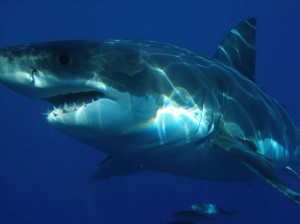They may be great and white, but the numbers of the great white shark who dwell off the central California coast are far fewer than biologists had thought.
Research led by UC Davis and Stanford University put the number at about 219.
The study, published this week in the journal Biology Letters, is the first rigorous scientific estimate of white shark numbers in the northeast Pacific Ocean. It is also the best estimate among the world’s three known white shark populations (the others are in Australia/New Zealand and South Africa).
So how does someone count sharks? Researchers, venturing in the ocean in small boats where white sharks congregate, lured sharks into photo range using a seal-shaped decoy on a fishing line, and snapped pictures; they later counted the number of individuals and statistically extrapolated the number to get the 219 total.
“This low number was a real surprise,” said UC Davis doctoral student Taylor Chapple, the study’s lead author. “It’s lower than we expected, and also substantially smaller than populations of other large marine predators, such as killer whales and polar bears. However, this estimate only represents a single point in time; further research will tell us if this number represents a healthy, viable population, or one critically in danger of collapse, or something in between.”
Check out this YouTube video showing clips from their new photo-census studies and earlier studies that put satellite-tracking tags on the large creatures.
http://www.youtube.com/watch?v=5poHfnS1kMA&feature=player_embedded#at=11
— Brenda Rees, Editor

